Projected Impact of Climate Change on Habitat Suitability of a Vulnerable Endemic Vachellia negrii (pic.serm.) kyal. & Boatwr (Fabaceae) in Ethiopia
Abstract
:1. Introduction
2. Materials and Methods
Species Occurrence and Environmental Data
3. Data Analysis
4. Result
4.1. Correlation among the Environmental Variables
4.2. Model Evaluation
4.3. Response Curves of Bioclimatic Variables
4.4. Potential Distribution of Vachellia negrii
4.5. Important Environmental Variables for Future Geographic Distribution of Vachellia negrii
4.6. Predicted Distribution of Vachellia negrii (Pic.-Serm.) Kyal. & Boatwr.
5. Discussion
5.1. Model Performance and Percent Contribution of Variables
5.2. Current Distribution
5.3. Future Distribution
5.4. Range Shift
5.5. Conservation Strategy
6. Conclusions
Author Contributions
Funding
Institutional Review Board Statement
Informed Consent Statement
Data Availability Statement
Conflicts of Interest
References
- Ehrlich, P.R.; Pringle, R.M. Where does biodiversity go from here? A grim business-as-usual forecast and a hopeful portfolio of partial solutions. Proc. Natl. Acad. Sci. USA 2008, 105, 11579–11586. [Google Scholar] [CrossRef] [Green Version]
- Rinawati, F.; Stein, K.; Lindner, A. Climate Change Impacts on Biodiversity—The Setting of a Lingering Global Crisis. Diversity 2013, 5, 114–123. [Google Scholar] [CrossRef] [Green Version]
- Pecl, G.T.; Araújo, M.B.; Bell, J.D.; Blanchard, J.; Bonebrake, T.C.; Chen, I.-C.; Clark, T.D.; Colwell, R.K.; Danielsen, F.; Evengård, B.; et al. Biodiversity redistribution under climate change: Impacts on ecosystems and human well-being. Science 2017, 355, eaai9214. [Google Scholar] [CrossRef] [PubMed]
- Parmesan, C. Ecological and Evolutionary Responses to Recent Climate Change. Annu. Rev. Ecol. Evol. Syst. 2006, 37, 637–669. [Google Scholar] [CrossRef] [Green Version]
- Chen, I.-C.; Hill, J.K.; Ohlemuller, R.; Roy, D.B.; Thomas, C.D. Rapid Range Shifts of Species Associated with High Levels of Climate Warming. Science 2011, 333, 1024–1026. [Google Scholar] [CrossRef]
- Bogale, G.A.; Tolossa, T.T. Climate change intensification impacts and challenges of invasive species and adaptation measures in Eastern Ethiopia. Sustain. Environ. 2021, 7, 1875555. [Google Scholar] [CrossRef]
- Chaudhary, C.; Richardson, A.J.; Schoeman, D.S.; Costello, M.J. Global warming is causing a more pronounced dip in marine species richness around the equator. Proc. Natl. Acad. Sci. USA 2021, 118. [Google Scholar] [CrossRef]
- Araújo, M.B.; Rahbek, C. How Does Climate Change Affect Biodiversity? Science 2006, 313, 1396–1397. [Google Scholar] [CrossRef] [PubMed]
- Ros, F.V.; Matesanz, S.; Guilhaumon, F.; Araújo, M.B.; Balaguer, L.; Benito-Garzón, M.; Cornwell, W.; Gianoli, E.; van Kleunen, M.; Naya, D.E.; et al. The effects of phenotypic plasticity and local adaptation on forecasts of species range shifts under climate change. Ecol. Lett. 2014, 17, 1351–1364. [Google Scholar] [CrossRef] [Green Version]
- King, N.G.; McKeown, N.; Smale, D.A.; Moore, P. The importance of phenotypic plasticity and local adaptation in driving intraspecific variability in thermal niches of marine macrophytes. Ecography 2018, 41, 1469–1484. [Google Scholar] [CrossRef]
- Berg, M.P.; Kiers, T.; Driessen, G.; Van Der Heijden, M.; Kooi, B.; Kuenen, F.; Liefting, M.; Verhoef, H.A.; Ellers, J. Adapt or disperse: Understanding species persistence in a changing world. Glob. Chang. Biol. 2010, 16, 587–598. [Google Scholar] [CrossRef]
- Taheri, S.; Naimi, B.; Rahbek, C.; Araújo, M.B. Improvements in reports of species redistribution under climate change are required. Sci. Adv. 2021, 7, eabe1110. [Google Scholar] [CrossRef] [PubMed]
- IPCC. Summary for policymakers. In Climate Change and Land: An IPCC Special Report on Climate Change, Desertification, Land Degradation, Sustainable Land Management, Food Security, and Greenhouse Gas Fluxes in Terrestrial Ecosystems; Shukla, P.R., Ed.; World Meteorological Organization: Geneva, Switzerland, 2019; pp. 1–43. [Google Scholar]
- Williams, J.E.; Blois, J.L. Range shifts in response to past and future climate change: Can climate velocities and species’ dispersal capabilities explain variation in mammalian range shifts? J. Biogeogr. 2018, 45, 2175–2189. [Google Scholar] [CrossRef]
- Bertrand, R.; Lenoir, J.; Piedallu, C.; Riofrío-Dillon, G.; De Ruffray, P.; Vidal, C.; Pierrat, J.-C.; Gégout, J.-C. Changes in plant community composition lag behind climate warming in lowland forests. Nat. Cell Biol. 2011, 479, 517–520. [Google Scholar] [CrossRef] [PubMed]
- Adhikari, D.; Barik, S.K.; Upadhaya, K. Habitat distribution modelling for reintroduction of Ilex khasianaPurk., a critically endangered tree species of northeastern India. Ecol. Eng. 2012, 40, 37–43. [Google Scholar] [CrossRef] [Green Version]
- Liu, X.; Pan, Y.; Zhu, X.; Li, S. Spatiotemporal variation of vegetation coverage in Qinling-Daba Mountains in relation to environmental factors. Acta Geogr. Sin. 2015, 5, 705–716. [Google Scholar] [CrossRef]
- Devictor, V.; Van Swaay, C.; Brereton, T.; Brotons, L.; Chamberlain, D.; Heliölä, J.; Herrando, S.; Julliard, R.; Kuussaari, M.; Lindström, Å.; et al. Differences in the climatic debts of birds and butterflies at a continental scale. Nat. Clim. Chang. 2012, 2, 121–124. [Google Scholar] [CrossRef]
- Hewitt, G.M. The genetic legacy of the Quaternary ice ages. Nature 2000, 405, 907–913. [Google Scholar] [CrossRef]
- Wershow, S.T.; DeChaine, E.G. Retreat to refugia: Severe habitat contraction projected for endemic alpine plants of the Olympic Peninsula. Am. J. Bot. 2018, 105, 760–778. [Google Scholar] [CrossRef] [Green Version]
- Staude, I.R.; Navarro, L.M.; Pereira, H.M. Range size predicts the risk of local extinction from habitat loss. Glob. Ecol. Biogeogr. 2020, 29, 16–25. [Google Scholar] [CrossRef] [Green Version]
- Engler, R.; Guisan, A.; Rechsteiner, L. An improved approach for predicting the distribution of rare and endangered species from occurrence and pseudo-absence data. J. Appl. Ecol. 2004, 41, 263–274. [Google Scholar] [CrossRef]
- Niskanen, A.K.J.; Niittynen, P.; Aalto, J.; Väre, H.; Luoto, M. Lost at high latitudes: Arctic and endemic plants under threat as climate warms. Divers. Distrib. 2019, 25, 809–821. [Google Scholar] [CrossRef] [Green Version]
- Davis, M.B. Range Shifts and Adaptive Responses to Quaternary Climate Change. Science 2001, 292, 673–679. [Google Scholar] [CrossRef] [Green Version]
- Thuiller, W.; Midgley, G.; Hughes, G.O.; Bomhard, B.; Drew, G.; Rutherford, M.C.; Woodward, F.I. Endemic species and ecosystem sensitivity to climate change in Namibia. Glob. Chang. Biol. 2006, 12, 759–776. [Google Scholar] [CrossRef]
- Dullinger, S.; Dirnböck, T.; Grabherr, G. Modelling climate change-driven treeline shifts: Relative effects of temperature increase, dispersal and invasibility. J. Ecol. 2004, 92, 241–252. [Google Scholar] [CrossRef]
- Ranjitkar, S.; Xu, J.; Shrestha, K.K.; Kindt, R. Ensemble forecast of climate suitability for the Trans-Himalayan Nyctaginaceae species. Ecol. Model. 2014, 282, 18–24. [Google Scholar] [CrossRef]
- Chala, D.; Brochmann, C.; Psomas, A.; Ehrich, D.; Gizaw, A.; Masao, C.A.; Bakkestuen, V.; Zimmermann, N. Good-bye to tropical alpine plant giants under warmer climates? Loss of range and genetic diversity in Lobelia rhynchopetalum. Ecol. Evol. 2016, 6, 8931–8941. [Google Scholar] [CrossRef] [PubMed]
- Willis, K.J.; Bhagwat, S.A. Biodiversity and Climate Change. Science 2009, 326, 806–807. [Google Scholar] [CrossRef] [PubMed]
- Chichorro, F.; Juslén, A.; Cardoso, P. A review of the relation between species traits and extinction risk. Biol. Conserv. 2019, 237, 220–229. [Google Scholar] [CrossRef]
- Dirnböck, T.; Essl, F.; Rabitsch, W. Disproportional risk for habitat loss of high-altitude endemic species under climate change. Glob. Chang. Biol. 2011, 17, 990–996. [Google Scholar] [CrossRef]
- Enquist, B.J.; Feng, X.; Boyle, B.; Maitner, B.; Newman, E.A.; Jørgensen, P.M.; Roehrdanz, P.R.; Thiers, B.M.; Burger, J.R.; Corlett, R.T.; et al. The commonness of rarity: Global and future distribution of rarity across land plants. Sci. Adv. 2019, 5, eaaz0414. [Google Scholar] [CrossRef] [Green Version]
- Lucas, P.M.; Suarez, M.G.; Revilla, E. Range area matters, and so does spatial configuration: Predicting conservation status in vertebrates. Ecography 2019, 42, 1103–1114. [Google Scholar] [CrossRef] [Green Version]
- Bekele, T. Phyosociology and Ecology of Humid Afromontane Forest on the Central plateau of Ethiopia. J. Veg. Sci. 1994, 5, 87–98. [Google Scholar] [CrossRef] [Green Version]
- Teketay, D.; Senbeta, F.; Maclachlan, M.; Bekele, M.; Barklund, P. Edible Wild Plants in Ethiopia; Addis Ababa University Press: Addis Ababa, Ethiopia, 2010; p. 575. [Google Scholar]
- Wassie, A.; Sterck, F.J.; Bongers, F. Species structural diversity of church forests in a fragmented Ethiopian highlands. J. Veg. Sci. 2010, 21, 938–948. [Google Scholar] [CrossRef]
- Hunde, A.; Thulin, M. Fabaceae. In Flora of Ethiopia; Addis Ababa University Press: Addis Ababa, Ethiopia, 1989; Volume 3, p. 670. [Google Scholar]
- Vivero, J.L.; Kelbessa, E.; Demissew, S. The Red List of Endemic Trees & Shrubs of Ethiopia and Eritrea. In The Red List of Endemic Trees & Shrubs of Ethiopia and Eritrea; Unpublished.
- Phillips, S. A Brief Tutorial on Maxent. AT&T Research. Retrieved March 2019 from American Museum of Natural History. 2006. Available online: https://biodiversityinformatics.amnh.org/open_source/maxent/Maxent_tutorial2017.pdf (accessed on 11 June 2021).
- Remya, K.; Ramachandran, A.; Jayakumar, S. Predicting the current and future suitable habitat distribution of Myristica dactyloidesGaertn. using MaxEnt model in the Eastern Ghats, India. Ecol. Eng. 2015, 82, 184–188. [Google Scholar] [CrossRef]
- Sarikaya, O.; Karaceylan, I.B.; Sen, I. Maximum entropy modeling (maxent) of current and future distributions of ipsmannsfeldi (wachtl, 1879) (curculionidae: Scolytinae) in turkey. Appl. Ecol. Environ. Res. 2018, 16, 2527–2535. [Google Scholar] [CrossRef]
- Elith, J.; Graham, C.H.; Anderson, R.P.; Dudík, M.; Ferrier, S.; Guisan, A.; Hijmans, R.J.; Huettmann, F.; Leathwick, J.R.; Lehmann, A.; et al. Novel methods improve prediction of species’ distributions from occurrence data. Ecography 2006, 29, 129–151. [Google Scholar] [CrossRef] [Green Version]
- Poloczanska, E.; Brown, C.; Sydeman, W.J.; Kiessling, W.; Schoeman, D.; Moore, P.; Brander, K.; Bruno, J.F.; Buckley, L.B.; Burrows, M.; et al. Global imprint of climate change on marine life. Nat. Clim. Chang. 2013, 3, 919–925. [Google Scholar] [CrossRef]
- Brown, J.L. SDMtoolbox: A python-based GIS toolkit for landscape genetic, biogeographic and species distribution model analyses. Methods Ecol. Evol. 2014, 5, 694–700. [Google Scholar] [CrossRef]
- Gebrewahid, Y.; Abrehe, S.; Meresa, E.; Eyasu, G.; Abay, K.; Gebreab, G.; Kidanemariam, K.; Adissu, G.; Abreha, G.; Darcha, G. Current and future predicting potential areas of Oxytenantheraabyssinica (A. Richard) using MaxEnt model under climate Northern Ethiopia. Ecol. Process. 2020, 9, 1–15. [Google Scholar] [CrossRef] [Green Version]
- Warren, D.L.; Matzke, N.J.; Cardillo, M.; Baumgartner, J.B.; Beaumont, L.J.; Turelli, M.; Glor, R.E.; Huron, N.A.; Simões, M.; Iglesias, T.L.; et al. ENMTools 1.0: An R package for comparative ecological biogeography. Ecography 2021, 44, 504–511. [Google Scholar] [CrossRef]
- Schmidt, H.; Radinger, J.; Teschlade, D.; Stoll, S. The role of spatial units in modelling freshwater fish distributions: Comparing a subcatchment and river network approach using MaxEnt. Ecol. Model. 2020, 418, 108937. [Google Scholar] [CrossRef]
- Phillips, S.J.; Elith, J. POC plots: Calibrating species distribution models with presence-only data. Ecology 2010, 91, 2476–2484. [Google Scholar] [CrossRef] [PubMed]
- David, W.; Hosmer, J.; Lemeshow, S.; Sturdivant, R.X. Applied Logistic Regression, 3rd ed.; John Wiley & Sons, Ltd.: Hoboken, NJ, USA, 2013. [Google Scholar]
- Phillips, S.J.; Dudík, M. Modeling of species distributions with MaxEnt: New extensions and a comprehensive evaluation. Ecography 2008, 31, 161–175. [Google Scholar] [CrossRef]
- Swets, J.A. Measuring the accuracy of diagnostic systems. Science 1988, 240, 1285–1293. [Google Scholar] [CrossRef] [PubMed] [Green Version]
- Shcheglovitova, M.; Anderson, R.P. Estimating optimal complexity for ecological niche models: A jackknife approach for species with small sample sizes. Ecol. Model. 2013, 269, 9–17. [Google Scholar] [CrossRef]
- Yang, X.; Kushwaha, S.; Saran, S.; Xu, J.; Roy, P. Maxent modeling for predicting the potential distribution of medicinal plant, Justicia adhatoda L. in Lesser Himalayan foothills. Ecol. Eng. 2013, 51, 83–87. [Google Scholar] [CrossRef]
- Vilà, M.; Gassó, N.; Thuiller, W.; Pino, J. Potential distribution range of invasive plant species in Spain. NeoBiota 2012, 12, 25–40. [Google Scholar] [CrossRef] [Green Version]
- Zhao, D.; He, H.; Wang, W.; Wang, L.; Du, H.; Liu, K.; Zong, S. Predicting Wetland Distribution Changes under Climate Change and Human Activities in a Mid- and High-Latitude Region. Sustainability 2018, 10, 863. [Google Scholar] [CrossRef] [Green Version]
- Yi, Y.-J.; Zhou, Y.; Cai, Y.-P.; Yang, W.; Li, Z.-W.; Zhao, X. The influence of climate change on an endangered riparian plant species: The root of riparian Homonoia. Ecol. Indic. 2018, 92, 40–50. [Google Scholar] [CrossRef]
- Zhou, Y.; Zhang, Z.; Zhu, B.; Cheng, X.; Yang, L.; Gao, M.; Kong, R. MaxEnt Modeling Based on CMIP6 Models to Project Potential Suitable Zones for Cunninghamia lanceolata in China. Forests 2021, 12, 752. [Google Scholar] [CrossRef]
- He, J.; Yan, C.; Holyoak, M.; Wan, X.; Ren, G.; Hou, Y.; Xie, Y.; Zhang, Z. Quantifying the effects of climate and anthropogenic change on regional species loss in China. PLoS ONE 2018, 13, e0199735. [Google Scholar] [CrossRef] [Green Version]
- Chunco, A.J.; Phimmachak, S.; Sivongxay, N.; Stuart, B.L. Predicting Environmental Suitability for a Rare and Threatened Species (Lao Newt, Laotritonlaoensis) Using Validated Species Distribution Models. PLoS ONE 2013, 8, e59853. [Google Scholar] [CrossRef]
- Pearce, J.; Ferrier, S. Evaluating the predictive performance of habitat models developed using logistic regression. Ecol. Model. 2000, 133, 225–245. [Google Scholar] [CrossRef] [Green Version]
- Fielding, A.H.; Bell, J.F. A review of methods for the assessment of prediction errors in conservation presence/absence models. Environ. Conserv. 1997, 24, 38–49. [Google Scholar] [CrossRef]
- Van Der Putten, W.H.; Macel, M.; Visser, M.E. Predicting species distribution and abundance responses to climate change: Why it is essential to include biotic interactions across trophic levels. Philos. Trans. R. Soc. B Biol. Sci. 2010, 365, 2025–2034. [Google Scholar] [CrossRef]
- Yackulic, C.B.; Chandler, R.B.; Zipkin, E.F.; Royle, J.; Nichols, J.D.; Grant, E.H.C.; Veran, S. Presence-only modelling using MAXENT: When can we trust the inferences? Methods Ecol. Evol. 2012, 4, 236–243. [Google Scholar] [CrossRef]
- Thibaud, E.; Petitpierre, B.; Brönnimann, O.; Davison, A.C.; Guisan, A. Measuring the relative effect of factors affecting species distribution model predictions. Methods Ecol. Evol. 2014, 5, 947–955. [Google Scholar] [CrossRef]
- Pearson, R.G.; Raxworthy, C.J.; Nakamura, M.; Peterson, A.T. Predicting species distributions from small numbers of occurrence records: A test case using cryptic geckos in Madagascar. J. Biogeogr. 2006, 34, 102–117. [Google Scholar] [CrossRef]
- Çoban, H.O.; Örücü, Ö.K.; Arslan, E.S. MaxEnt Modeling for Predicting the Current and Future Potential Geographical Distribution of Quercus libani Olivier. Sustainability 2020, 12, 2671. [Google Scholar] [CrossRef] [Green Version]
- Çoban, H.O.; Çosgun, S. The role of topography in the spatial distribution of tree species in the Mediterranean region of Turkey. Fresenius Environ. Bull. 2020, 29, 1369–1378. [Google Scholar]
- Luoto, M.; Heikkinen, R.K. Disregarding topographical heterogeneity biases species turnover assessments based on bioclimatic models. Glob. Chang. Biol. 2007, 14, 483–494. [Google Scholar] [CrossRef]
- Dobrowski, S.Z. A climatic basis for microrefugia: The influence of terrain on climate. Glob. Chang. Biol. 2011, 17, 1022–1035. [Google Scholar] [CrossRef]
- Uzma, F.; Konappa, N.M.; Chowdappa, S. Diversity and extracellular enzyme activities of fungal endophytes isolated from medicinal plants of Western Ghats, Karnataka. Egypt. J. Basic Appl. Sci. 2016, 3, 335–342. [Google Scholar] [CrossRef] [Green Version]
- Zhong, L.; Ma, Y.; Salama, M.S.; Su, Z. Assessment of vegetation dynamics and their response to variations in precipitation and temperature in the Tibetan Plateau. Clim. Chang. 2010, 103, 519–535. [Google Scholar] [CrossRef]
- Phillips, S.J.; Anderson, R.P.; Schapire, R.E. Maximum entropy modeling of species geographic distributions. Ecol. Model 2006, 190, 231–259. [Google Scholar] [CrossRef] [Green Version]
- Xu, M.; Xue, X. Analysis on the effects of climate warming on growth and phenology of alpine plants. J. Arid. Land Resour. Environ. 2013, 27, 137–141. [Google Scholar]
- Stohlgren, T.J.; Jarnevich, C.S.; Esaias, W.E.; Morisette, J.T. Bounding species distribution models. Curr. Zool. 2011, 57, 642–647. [Google Scholar] [CrossRef] [Green Version]
- Albano, P.G.; Steger, J.; Bošnjak, M.; Dunne, B.; Guifarro, Z.; Turapova, E.; Hua, Q.; Kaufman, D.S.; Rilov, G.; Zuschin, M. Native biodiversity collapse in the eastern Mediterranean. Proc. R. Soc. B Biol. Sci. 2021, 288, 20202469. [Google Scholar] [CrossRef]
- Oduor, A.M.; Leimu, R.; van Kleunen, M. Invasive plant species are locally adapted just as frequently and at least as strongly as native plant species. J. Ecol. 2016, 104, 957–968. [Google Scholar] [CrossRef] [Green Version]
- Sintayehu, D.W. Impact of climate change on biodiversity and associated key ecosystem services in Africa: A systematic review. Ecosyst. Health Sustain. 2018, 4, 225–239. [Google Scholar] [CrossRef] [Green Version]
- Sintayehu, D.W.; Dalle, G.; Bobasa, A.F. Impacts of climate change on current and future invasion of Prosopis juliflora in Ethiopia: Environmental and socio-economic implications. Heliyon 2020, 6, e04596. [Google Scholar] [CrossRef]
- Watts, G.; Battarbee, R.W.; Bloomfield, J.; Crossman, J.; Daccache, A.; Durance, I.; Elliott, J.A.; Garner, G.; Hannaford, J.; Hannah, D.; et al. Climate change and water in the UK—Past changes and future prospects. Prog. Phys. Geogr. Earth Environ. 2015, 39, 6–28. [Google Scholar] [CrossRef]
- Janowiak, M.K.; Iverson, L.; Fosgitt, J.; Handler, S.D.; Dallman, M.; Thomasma, S.; Hutnik, B.; Swanston, C.W. Assessing Stand-Level Climate Change Risk Using Forest Inventory Data and Species Distribution Models. J. For. 2017, 115, 222–229. [Google Scholar] [CrossRef]
- Pecchi, M.; Marchi, M.; Burton, V.; Giannetti, F.; Moriondo, M.; Bernetti, I.; Bindi, M.; Chirici, G. Species distribution modelling to support forest management. A literature review. Ecol. Model 2019, 411, 108817. [Google Scholar] [CrossRef]

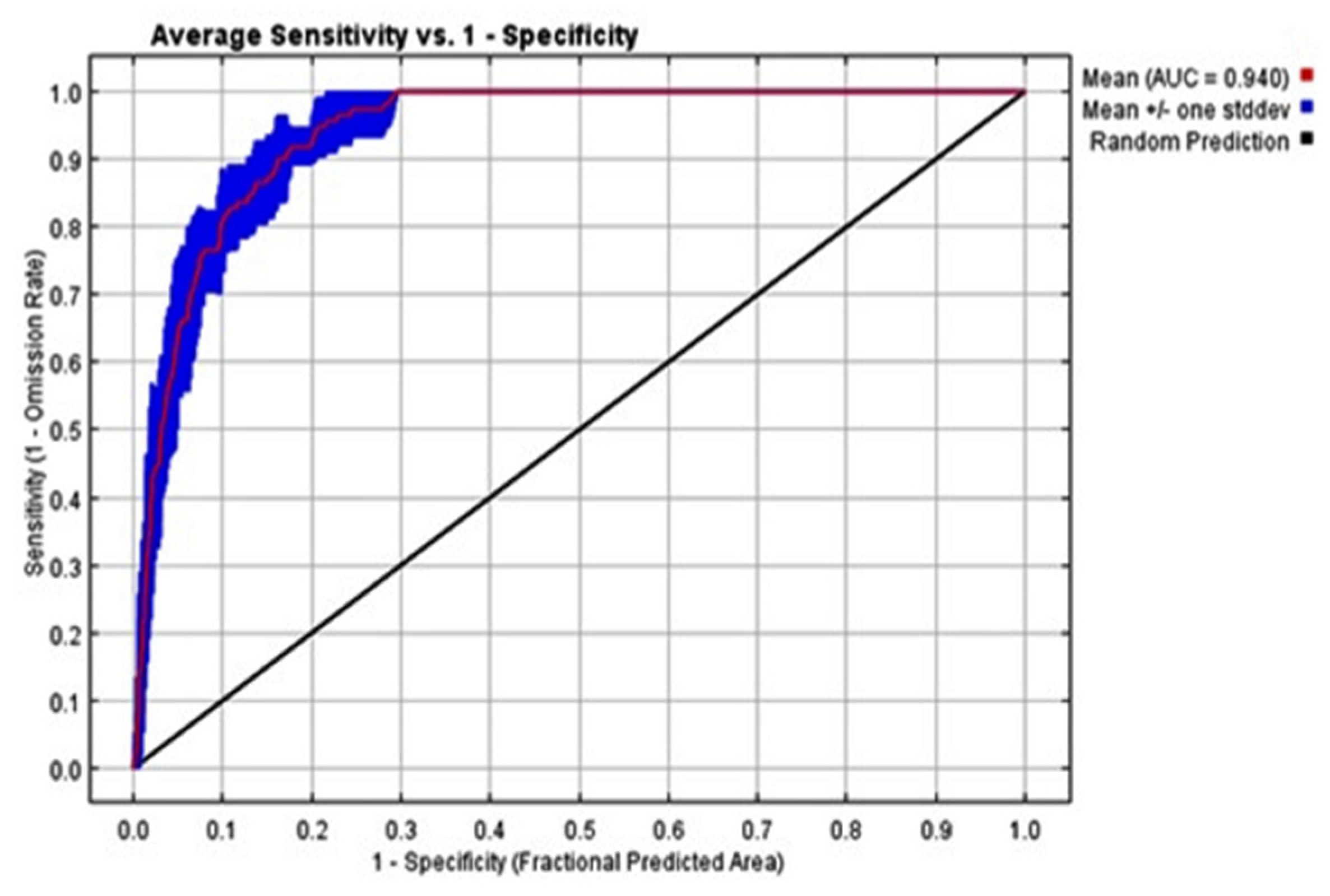
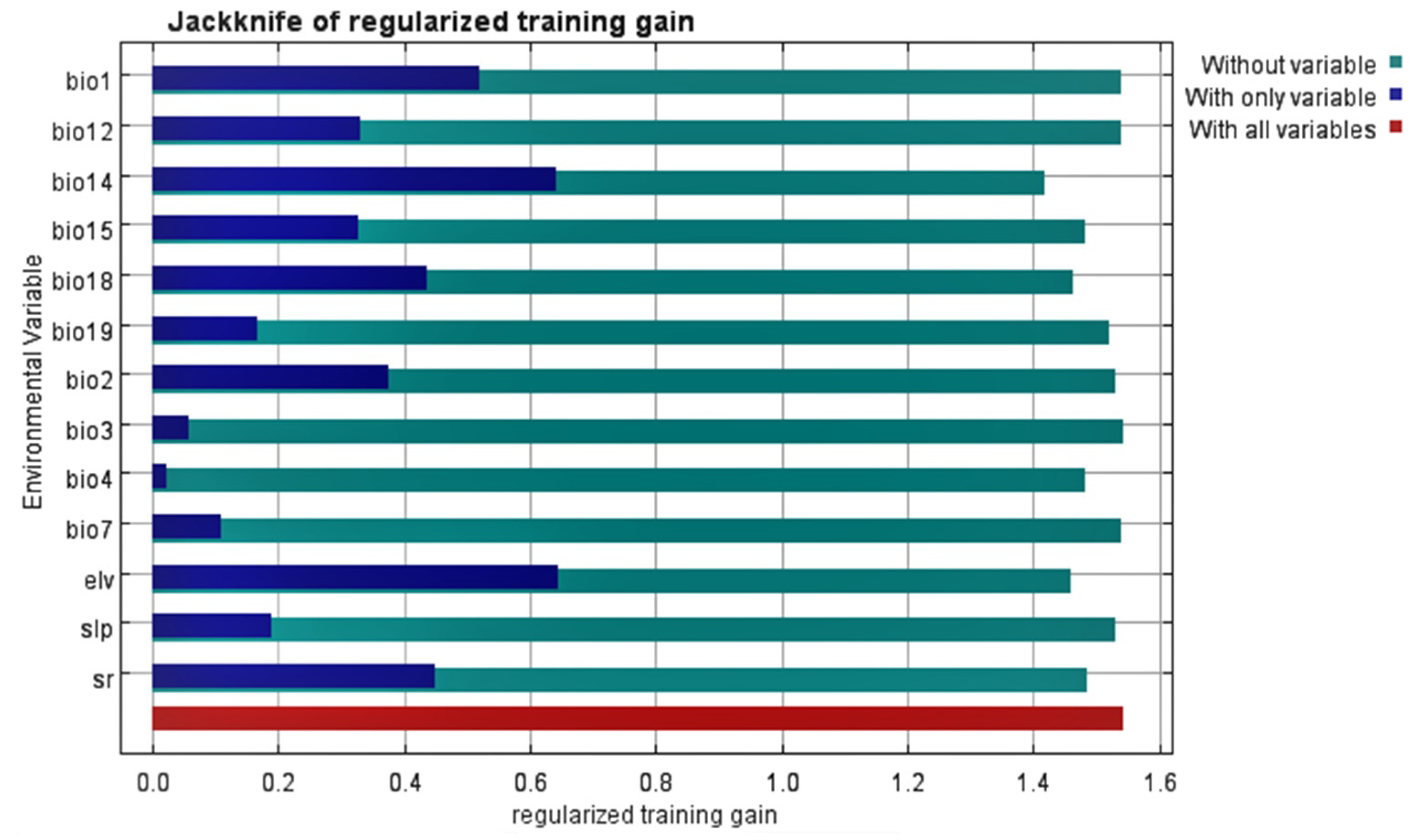
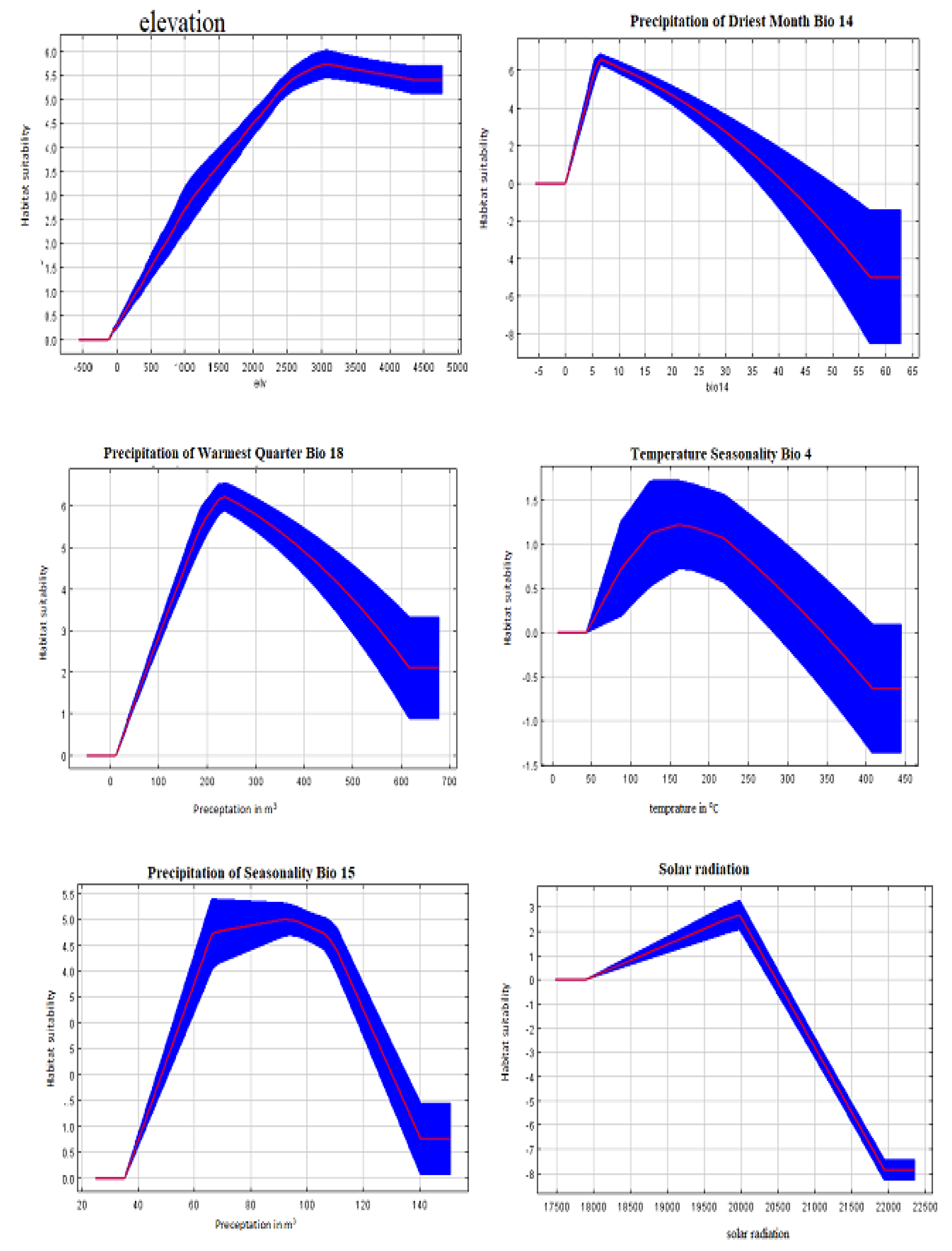
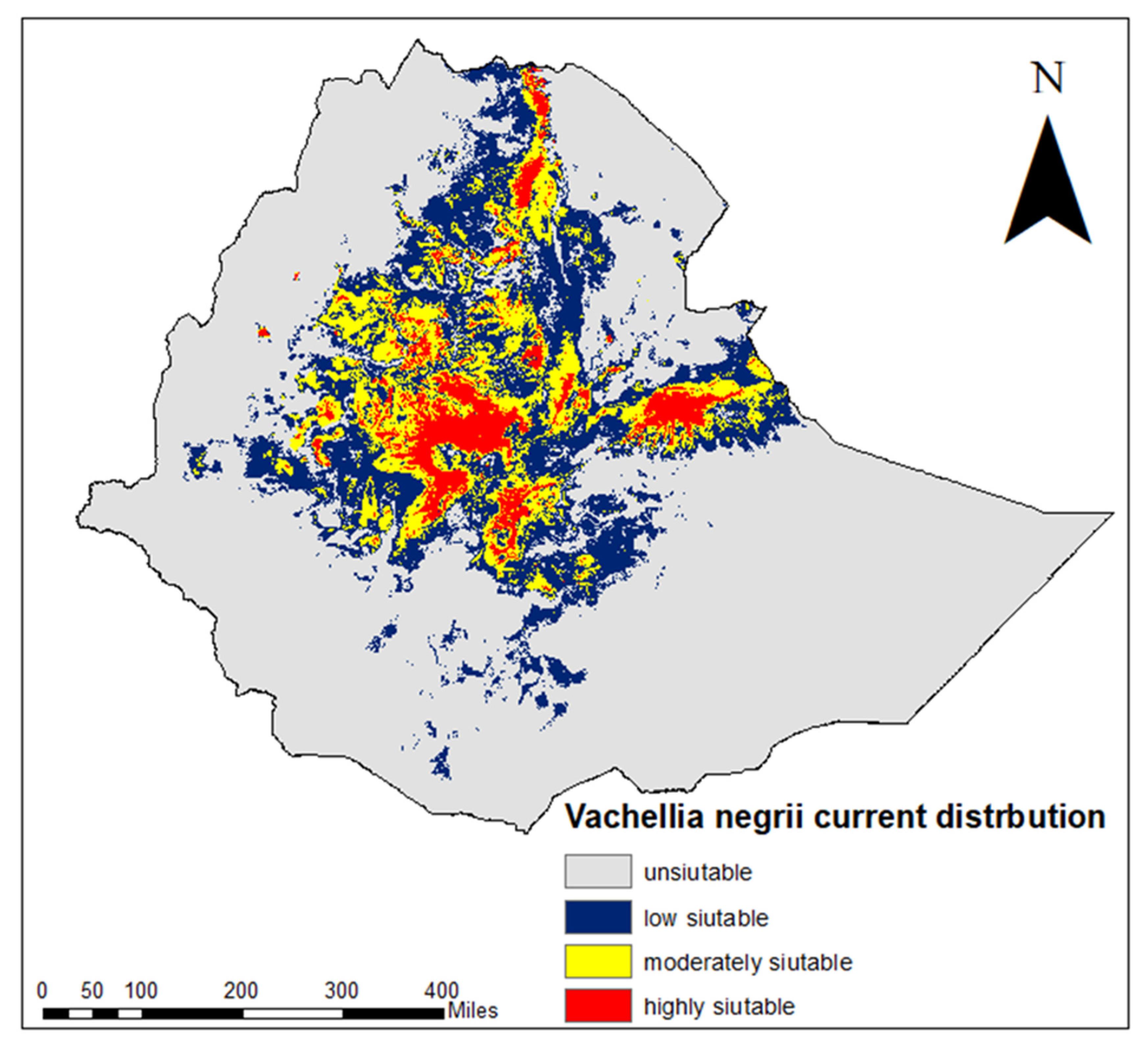
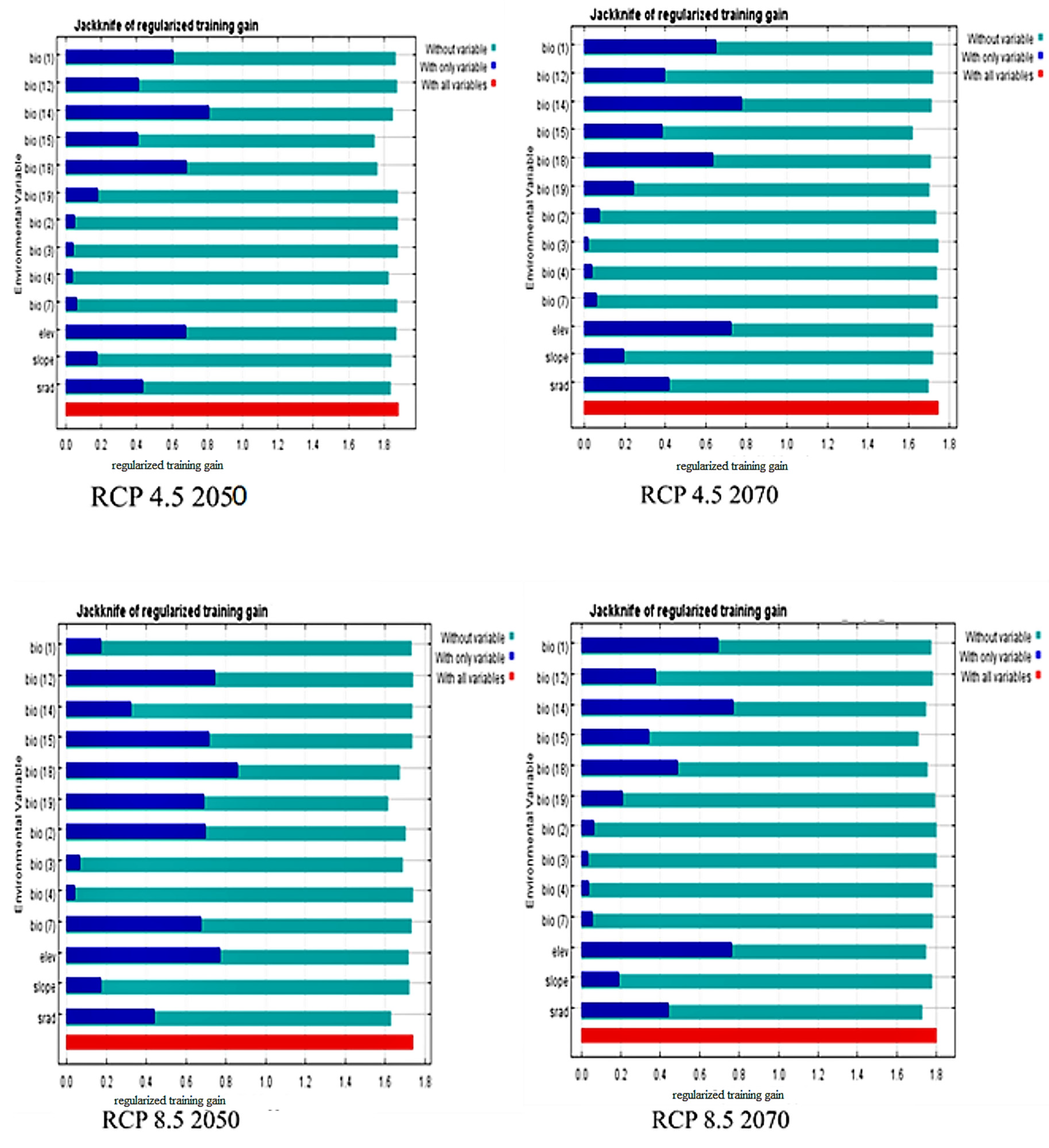

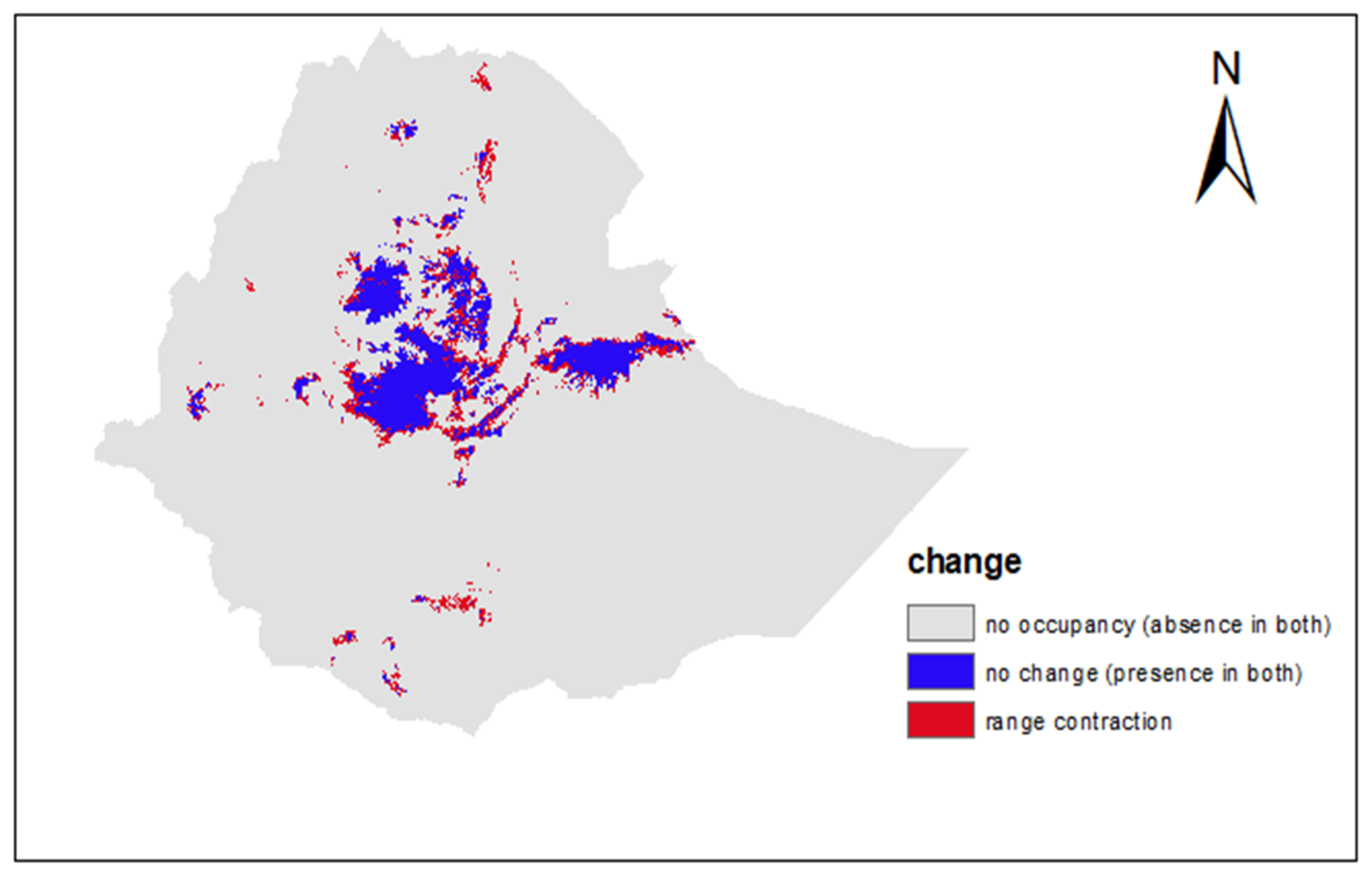
| Variable | Variable Type | Unit |
|---|---|---|
| Bio 1 | Annual Mean Temperature | °C |
| Bio 2 | Mean Diurnal Range (Mean of monthly (max temp–min temp)) | °C |
| Bio 3 | Isothermality (BIO2/BIO7) (×100) | °C |
| Bio 4 | Temperature Seasonality (standard deviation ×100) | °C |
| Bio 5 | Max Temperature of Warmest Month | °C |
| Bio 6 | Min Temperature of Coldest Month | °C |
| Bio 7 | Temperature Annual Range (BIO5-BIO6) | °C |
| Bio 8 | Mean Temperature of Wettest Quarter | °C |
| Bio 9 | Mean Temperature of Driest Quarter | °C |
| Bio 10 | Mean Temperature of Warmest Quarter | °C |
| Bio 11 | Mean Temperature of Coldest Quarter | °C |
| Bio 12 | Annual Precipitation | °C |
| Bio 13 | Precipitation of Wettest Month | Mm |
| Bio 14 | Precipitation of Driest Month | Mm |
| Bio 15 | Precipitation Seasonality (Coefficient of Variation) | Mm |
| Bio 16 | Precipitation of Wettest Quarter | Mm |
| Bio 17 | Precipitation of Driest Quarter | Mm |
| Bio 18 | Precipitation of Warmest Quarter | Mm |
| Bio 19 | Precipitation of Coldest Quarter | Mm |
| Elevation | Altitude | M |
| Solar radiation | Solar radiation | |
| Slope | Slope | % |
| layer | Sri | Bio1 | Bio2 | Bio3 | Bio4 | Bio5 | Bio6 | Bio7 | Bio8 | Bio9 | Bio10 | Bio11 | Bio12 | Bio13 | Bio14 | Bio15 | Bio16 | Bio17 | Bio18 | Bio19 | Elv | Asp |
|---|---|---|---|---|---|---|---|---|---|---|---|---|---|---|---|---|---|---|---|---|---|---|
| Sri | 1 | 0.25 | –0.15 | 0.33 | −0.49 | 0.13 | 0.34 | −0.41 | 0.29 | 0.23 | 0.13 | 0.35 | −0.45 | −0.44 | −0.23 | 0.36 | −0.47 | −0.23 | −0.035 | −0.36 | −0.31 | −0.25 |
| Bio1 | 1 | −0.45 | −0.53 | 0.41 | 0.96 | 0.96 | −0.04 | 0.97 | 0.97 | 0.98 | 0.98 | −0.63 | −0.618 | −0.32 | 0.16 | −0.60 | −0.36 | −0.54 | −0.31 | −0.96 | −0.43 | |
| Bio2 | 1 | 0.40 | −0.05 | −0.26 | −0.63 | 0.70 | −0.50 | −0.47 | −0.42 | −0.46 | 0.36 | 0.46 | 0.10 | 0.03 | 0.44 | 0.13 | 0.28 | 0.22 | 0.58 | 0.22 | ||
| Bio3 | 1 | −0.87 | −0.62 | 0.42 | −0.35 | −0.56 | −0.46 | −0.62 | 0.39 | 0.38 | 0.34 | 0.29 | 0.08 | 0.31 | 0.29 | 0.41 | 0.18 | 0.45 | 0.15 | |||
| Bio4 | 1 | 0.58 | 0.23 | 0.63 | 0.40 | 0.34 | 0.53 | 0.25 | −0.21 | −0.10 | −0.25 | −0.04 | −0.08 | 0.137 | 0.28 | −0.02 | −0.28 | −0.04 | ||||
| Bio5 | 1 | 0.85 | 0.22 | 0.93 | 0.90 | 0.97 | 0.91 | −0.60 | −0.55 | −0.35 | 0.16 | −0.54 | 0.29 | 0.41 | −0.30 | −0.89 | −0.38 | |||||
| Bio6 | 1 | −0.31 | 0.94 | 0.94 | 0.91 | 0.97 | −0.633 | −0.64 | −0.29 | 0.18 | −0.63 | −0.38 | −0.38 | −0.341 | −0.96 | −0.43 | ||||||
| Bio7 | 1 | −0.07 | −0.12 | 0.06 | −0.16 | 0.077 | 0.19 | −0.10 | −0.04 | 0.20 | −0.33 | −0.53 | 0.08 | 0.19 | 0.11 | |||||||
| Bio8 | 1 | 0.91 | 0.952 | 0.94 | −0.72 | −0.71 | −0.33 | 0.15 | −0.70 | −0.07 | −0.012 | −0.45 | −0.94 | −0.44 | ||||||||
| Bio9 | 1 | 0.95 | 0.96 | −0.52 | −0.55 | −0.23 | 0.10 | −0.52 | −0.36 | −0.49 | −0.19 | −0.94 | −0.39 | |||||||||
| Bio10 | 1 | 0.94 | −0.59 | −0.55 | −0.34 | 0.15 | −0.53 | −0.27 | −0.53 | −0.27 | −0.93 | −0.39 | ||||||||||
| Bio11 | 1 | −0.63 | −0.60 | −0.30 | 0.20 | −0.59 | −0.38 | −0.51 | −0.31 | −0.97 | −0.44 | |||||||||||
| Bio12 | 1 | 0.85 | 0.57 | −0.31 | 0.91 | −0.34 | 0.44 | 0.77 | 0.61 | 0.35 | ||||||||||||
| Bio13 | 1 | 0.12 | 0.11 | 0.98 | 0.56 | 0.23 | 0.72 | 0.63 | 0.37 | |||||||||||||
| Bio14 | 1 | −0.67 | 0.26 | 0.177 | 0.46 | 0.30 | 0.30 | 0.24 | ||||||||||||||
| Bio15 | 1 | 0.01 | 0.974 | −0.35 | −0.09 | −0.14 | −0.09 | |||||||||||||||
| Bio16 | 1 | −0.75 | 0.25 | 0.78 | 0.61 | 0.35 | ||||||||||||||||
| Bio17 | 1 | 0.52 | 0.26 | 0.33 | 0.26 | |||||||||||||||||
| Bio18 | 1 | 0.12 | 0.49 | 0.21 | ||||||||||||||||||
| Bio19 | 1 | 0.33 | 0.23 | |||||||||||||||||||
| Elv | 1 | 0.46 | ||||||||||||||||||||
| Asp | 1 |
| Variables | Code | Current | 2050 | 2070 | |||||||
|---|---|---|---|---|---|---|---|---|---|---|---|
| RCP 4.5 | RCP 8.5 | RCP 4.5 | RCP 8.5 | ||||||||
| %c | PI | %c | PI | %c | PI | %c | PI | %c | PI | ||
| Annual Mean Temperature | Bio 1 | 0.2 | 0.9 | 0 | 4.5 | 0 | 0.8 | 0 | 4.7 | 0 | 2.2 |
| Mean Diurnal Range (Mean of monthly (max temp–min temp)) | Bio 2 | 2.9 | 2.1 | 0 | 0.4 | 0 | 9.5 | 0 | 0 | 0 | 0 |
| Isothermality (P2/P7) × (100) | Bio 3 | 0.1 | 0.1 | 0 | 5.5 | 0 | 3.7 | 0 | 0 | 0 | 0 |
| Temperature Seasonality (standard deviation × 100) | Bio 4 | 4.6 | 13.9 | 0 | 16.7 | 0.2 | 0 | 0 | 7.5 | 0 | 3.7 |
| Temperature Annual Range (P5–P6) | Bio 7 | 0.1 | 0.2 | 0 | 6.3 | 0 | 3.8 | 0 | 7.1 | 0.8 | 4.7 |
| Annual Precipitation | Bio12 | 0.1 | 2.4 | 0 | 2.5 | 0 | 0 | 0 | 4.1 | 0 | 2.7 |
| Precipitation of Driest Month | Bio 14 | 21.7 | 27.2 | 3 | 2.1 | 1 | 0.9 | 0 | 10.3 | 2 | 6.8 |
| Precipitation of Seasonality (Coefficient of Variation) | Bio 15 | 12.2 | 6.8 | 2.0 | 11.6 | 1 | 1.1 | 0 | 12.7 | 2 | 33.9 |
| Precipitation of Warmest Quarter | Bio 18 | 12.7 | 6.5 | 3.0 | 24.7 | 1 | 14.1 | 0 | 1 | 0 | 2.1 |
| Precipitation of Coldest Quarter | Bio 19 | 4 | 1.1 | 0 | 2.3 | 2 | 10.6 | 0 | 12.2 | 2 | 2.4 |
| Elevation | Elev | 26.4 | 30.4 | 50 | 17.1 | 60 | 22.4 | 79.4 | 21.1 | 70 | 27.4 |
| Solar radiation | Sr | 12.9 | 6.8 | 29.2 | 3.7 | 32.8 | 32.3 | 16.1 | 17.2 | 16 | 10.5 |
| Slope | Slp | 2.1 | 1.5 | 12.8 | 2 | 0.9 | 4.5 | 2 | 6.7 | 3.7 | |
| Climatic Period | RCP | Classes of Suitable Habitats | |||||||
|---|---|---|---|---|---|---|---|---|---|
| Highly Suitable | Moderately Suitable | Low Suitable | Unsuitable | ||||||
| Hectares | % | Hectares | % | Hectares | % | Hectares | % | ||
| Current | 4,314,153.941 | 3.80 | 9,394,670.699 | 8.29 | 18,423,842.68 | 16.26 | 81,177,180.2 | 71.64 | |
| 2050 | RCP 4.5 | 4,059,150.901 | 3.58 | 8,491,245.863 | 7.49 | 17,529,132.28 | 15.47 | 83,230,318.48 | 73.45 |
| RCP 8.5 | 3,745,769.595 | 3.3 | 7,303,036.612 | 6.45 | 16,657,887.62 | 14.28 | 85,603,153.7 | 75.97 | |
| 2070 | RCP 4.5 | 3,555,828.711 | 3.13 | 6,675,597.149 | 5.89 | 14,063,493.76 | 12.41 | 89,014,927.9 | 78.55 |
| RCP 8.5 | 2,676,601.245 | 2.36 | 10,035,562.54 | 8.85 | 14,171,535.86 | 12.50 | 86,426,147.87 | 76.27 | |
Publisher’s Note: MDPI stays neutral with regard to jurisdictional claims in published maps and institutional affiliations. |
© 2021 by the authors. Licensee MDPI, Basel, Switzerland. This article is an open access article distributed under the terms and conditions of the Creative Commons Attribution (CC BY) license (https://creativecommons.org/licenses/by/4.0/).
Share and Cite
Semu, A.A.; Bekele, T.; Lulekal, E.; Cariñanos, P.; Nemomissa, S. Projected Impact of Climate Change on Habitat Suitability of a Vulnerable Endemic Vachellia negrii (pic.serm.) kyal. & Boatwr (Fabaceae) in Ethiopia. Sustainability 2021, 13, 11275. https://doi.org/10.3390/su132011275
Semu AA, Bekele T, Lulekal E, Cariñanos P, Nemomissa S. Projected Impact of Climate Change on Habitat Suitability of a Vulnerable Endemic Vachellia negrii (pic.serm.) kyal. & Boatwr (Fabaceae) in Ethiopia. Sustainability. 2021; 13(20):11275. https://doi.org/10.3390/su132011275
Chicago/Turabian StyleSemu, Arayaselassie Abebe, Tamrat Bekele, Ermias Lulekal, Paloma Cariñanos, and Sileshi Nemomissa. 2021. "Projected Impact of Climate Change on Habitat Suitability of a Vulnerable Endemic Vachellia negrii (pic.serm.) kyal. & Boatwr (Fabaceae) in Ethiopia" Sustainability 13, no. 20: 11275. https://doi.org/10.3390/su132011275
APA StyleSemu, A. A., Bekele, T., Lulekal, E., Cariñanos, P., & Nemomissa, S. (2021). Projected Impact of Climate Change on Habitat Suitability of a Vulnerable Endemic Vachellia negrii (pic.serm.) kyal. & Boatwr (Fabaceae) in Ethiopia. Sustainability, 13(20), 11275. https://doi.org/10.3390/su132011275






